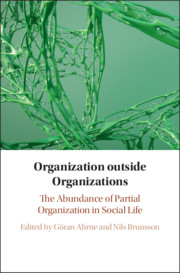Book contents
- Organization outside Organizations
- Organization outside Organizations
- Copyright page
- Contents
- Preface
- Contributors
- Introduction
- Part 1 Rules, Sanctions, Membership
- Part 2 Organization in and around Markets
- Part 3 Networks and Other Social Relationships
- 9 The Inter-Firm Network as Partial Organization?
- 10 An Organized Network: World Economic Forum and the Partial Organizing of Global Agendas
- 11 Organizing Intimacy
- 12 How Is ‘Organized Crime’ Organized?
- 13 Brotherhood as an Organized Social Relationship
- Part 4 Social Movements and Collective Action
- Part 5 The Partial Organization of Formal Organizations
- Conclusion
- Index
- References
12 - How Is ‘Organized Crime’ Organized?
from Part 3 - Networks and Other Social Relationships
Published online by Cambridge University Press: 11 July 2019
- Organization outside Organizations
- Organization outside Organizations
- Copyright page
- Contents
- Preface
- Contributors
- Introduction
- Part 1 Rules, Sanctions, Membership
- Part 2 Organization in and around Markets
- Part 3 Networks and Other Social Relationships
- 9 The Inter-Firm Network as Partial Organization?
- 10 An Organized Network: World Economic Forum and the Partial Organizing of Global Agendas
- 11 Organizing Intimacy
- 12 How Is ‘Organized Crime’ Organized?
- 13 Brotherhood as an Organized Social Relationship
- Part 4 Social Movements and Collective Action
- Part 5 The Partial Organization of Formal Organizations
- Conclusion
- Index
- References
Summary
In this chapter, we explore the usefulness of applying the idea of partial organization as one way of mitigating the confusion surrounding the notion of organized crime. We examine three types of collectivities that are usually seen as examples of organized crime: outlaw motorcycle gangs (OMCs), street gangs, and mafias. When we examine the occurrence of organizational elements, we find substantial differences among these three cases not only in the amount of their organization, but also in the ways in which they are organized. A few multinational outlaw motorcycle gangs have gradually been able to form strong formal organizations containing all organizational elements. For a mafia, the situation is quite the opposite. Because its embeddedness in kinship relationships provides cohesion and protection, it needs little organization. Through its strong kinship ties, a mafia has access to several functional equivalents to the organizational elements one can find in OMCs. In street gangs the appearance of organizational elements varies among the gangs, and they rarely have more than a few elements at any one time. One obstacle for the organization of street gangs is their local embeddedness and limited duration, which loosen the boundaries of the gang.
Keywords
- Type
- Chapter
- Information
- Organization outside OrganizationsThe Abundance of Partial Organization in Social Life, pp. 253 - 270Publisher: Cambridge University PressPrint publication year: 2019
References
- 1
- Cited by

